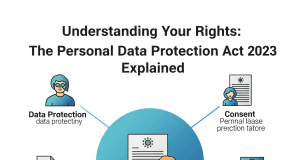As digital transformation accelerates across industries, data privacy has become a paramount concern. The introduction of the Personal Data Protection Act (PDPA) 2023 signifies a drastic shift in the regulatory landscape, emphasizing the importance of safeguarding personal data. This article delves into compliance strategies that businesses must adopt to navigate the complexities of the new legislation.
Understanding the PDPA 2023
The Personal Data Protection Act 2023 aims to enhance privacy protections for individuals while imposing stricter obligations on organizations that collect, store, and process personal data. Key provisions include enhanced consent requirements, data minimization principles, rights to data access and deletion, and substantial penalties for non-compliance.
Key Features of the PDPA 2023
- Enhanced Consent Requirements: Organizations must obtain explicit consent from individuals before collecting their data.
- Data Minimization: Only data that is necessary for a specific purpose may be collected and processed.
- Transparency and Communication: Businesses must be clear about their data handling practices and inform individuals of their rights.
- Data Subject Rights: Individuals have the right to access their data, request corrections, and demand deletion.
- Heavy Penalties: Non-compliance can lead to significant fines, damaging a company’s reputation and financial standing.
Compliance Strategies for Businesses
1. Conduct a Data Audit
Begin by evaluating the types of personal data collected and the purposes for which it is used. A comprehensive data audit helps in identifying:
- Data sources and flows
- Data retention periods
- Security measures currently in place
This audit will serve as a foundation for developing robust data management practices aligned with the PDPA.
2. Implement Clear Consent Mechanisms
Revise your consent practices to ensure they are clear, concise, and granular. This can include:
- Providing detailed information about data processing activities
- Allowing individuals to provide consent for specific uses of their data
- Offering easy methods to withdraw consent at any time
3. Develop a Data Protection Policy
Create a comprehensive data protection policy that outlines how your organization will comply with the PDPA. This should include:
- Procedures for data collection and processing
- Security measures to protect personal data
- Protocols for data breach notifications
4. Train Employees on Data Protection
Educate employees about their responsibilities under the PDPA, emphasizing the importance of data protection. Training sessions should cover:
- Understanding personal data and sensitive data
- Recognizing data breaches and reporting protocols
- Best practices for data handling and privacy
5. Enhance Data Security Measures
Invest in advanced cybersecurity measures to protect personal data from unauthorized access and breaches. This can involve:
- Regular security assessments and audits
- Implementing encryption and secure storage solutions
- Establishing access controls and authentication protocols
6. Establish a Data Subject Rights Framework
Create a process for individuals to exercise their rights under the PDPA. Ensure that your organization can:
- Quickly respond to access requests
- Facilitate data corrections and deletions
- Maintain records of requests and responses for accountability
7. Appoint a Data Protection Officer (DPO)
Consider appointing a DPO responsible for overseeing data protection strategies and compliance. The DPO’s role should include:
- Monitoring adherence to data protection laws
- Serving as a point of contact for regulatory authorities and data subjects
- Offering guidance on data-related compliance issues
8. Engage with Legal and Compliance Experts
Consulting with legal and compliance professionals can provide invaluable insights into navigating the complexities of the PDPA. These experts can assist in drafting policies, conducting audits, and ensuring that every aspect of your operations is compliant with the law.
9. Regularly Review and Update Policies
The regulatory landscape is volatile, making it essential to regularly review and update data protection policies and practices. Establish a routine for:
- Monitoring changes in legislation
- Assessing the effectiveness of current compliance measures
- Integrating lessons learned from data incidents or breaches
Conclusion
With the implementation of the Personal Data Protection Act 2023, organizations face a critical mandate to protect personal data and uphold individuals’ privacy rights. By adopting robust compliance strategies, businesses can mitigate risks, enhance their reputations, and build trust with customers. Failing to prioritize data protection could result in significant financial and reputational damage. It’s not just about compliance; it’s about fostering a culture of accountability and responsibility in the digital age.









